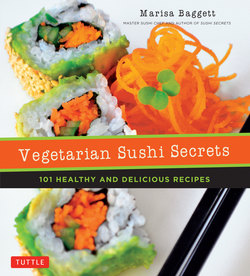Читать книгу Vegetarian Sushi Secrets - Marisa Baggett - Страница 8
ОглавлениеTypes of Sushi
Are you ready to roll?
First things first. Having a basic knowledge of sushi types, proper pantry staples, equipment, sushi-rice making, and recipes for sauces and condiments that you will use over and over again is the foundation of sushi success. Learning about various sushi types can expand your horizons. After purchasing sushi pantry staples, prevent waste by learning to store items properly. Improvising and using tools you already have on hand will save money.
When most people think of sushi, maki, or rolled sushi, is what comes to mind. But sushi takes many forms, each with its own unique flavor and preparation.
NIGIRI SUSHI
Nigiri hand-formed sushi is the crown jewel of sushi. It consists of a bed of rice with a spectacularly simple yet beautiful topping. Even in vegetarian preparations, the most unique and flavorful toppings are draped over a carefully prepared bed of rice. Nigiri is meant to be experienced topping-side first. To eat it, forget the chopsticks! Pick the sushi up with your fingers, flip it upside down, and place it on your tongue topping-side down. If it requires soy sauce, dip the topping rather than the rice to avoid a mess. Many vegetables will require a quick dip in boiling water or a dance across a sauté pan to release their aroma and improve their texture before adorning nigiri sushi.
INARI SUSHI
Fried tofu that has been simmered in a sweetened soy broth forms an edible pouch for sushi rice. The rice can be stuffed inside the pouch, then covered with assorted toppings. It may also be tossed with other ingredients before being stuffed inside the pouches. Unlike most forms of sushi, inari sushi is not meant to be eaten in a single bite. The filling and the delicious casing that surrounds it are multi-bite delights that deliver a big impact for very little effort.
GUNKAN-MAKI
Like nigiri sushi, gunkan-maki begins as a little bed of hand-shaped rice. A wide strip of nori is placed around the rice to form a wall that can be filled. The fillings are usually too moist or loose to be used to fill a cut sushi roll. Gunkan-maki are sometimes referred to as “battleship maki,” the literal meaning of the name.
HOSO-MAKI
These are simple, thin sushi rolls that feature the nori on the outside. Inside, a minimal amount of sushi rice is paired with one or perhaps two show-worthy fillings, like a pickle, or a vegetable simmered in flavored broth.
FUTO-MAKI
If you prefer many fillings at once, these thick sushi rolls will quickly become your favorite. Futo-maki can accommodate an abundance of ingredients. Just keep in mind that thick rolls fall under the one-bite category. No matter how thick, they should be enjoyed in a single bite.
URA-MAKI
If you’ve been to a sushi bar, then you will most likely recognize inside-out rolls. As their name implies, the sushi rice is on the outside of the roll. While some may think of this as a way to mask the flavor of the nori, I prefer to think of it as a way to showcase sushi’s most vital and most essential element—the sushi rice. Inside-out rolls are extremely versatile, as they can hold multiple fillings. Sometimes, colorful toppings such as avocado are pressed onto the outside of the rolls.
TEMAKI
For temaki hand rolls, nori is filled with sushi rice and desired fillings, then wrapped into a personal single-serve cone. Hand rolls are not meant to be cut before serving. Enjoy by simply taking bites of the cone.
